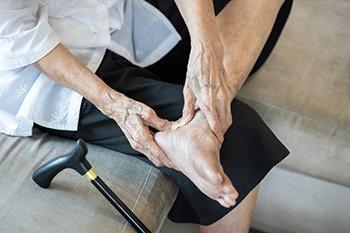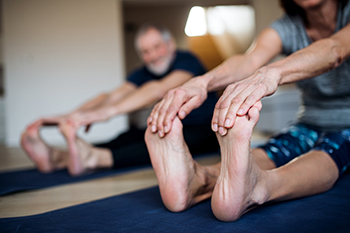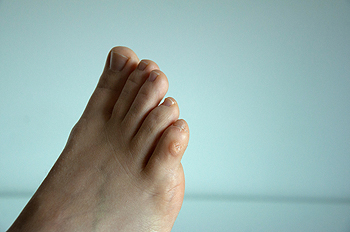

It is easy to recognize the symptoms of peripheral neuropathy, a condition that results from damage to the nerves in the body’s extremities. Burning, stabbing, and sometimes tingling pain in the feet are common, along with numbness and weakness. This is the result of the brain sending incorrect messages to the feet and toes. Peripheral neuropathy can be caused by diabetes, as the result of prolonged high blood sugar levels. Other causes include side effects of certain medications, hereditary factors, and autoimmune or kidney disease. It can also be a side effect of an underlying condition, such as obesity, alcohol abuse, and high blood pressure. In addition, a deficiency of vitamin B12 has been linked to developing peripheral neuropathy. While this condition is rarely cured, it can be managed to help reduce the symptoms. For more information about peripheral neuropathy that affects the feet and toes, it is suggested that you consult a podiatrist.
Neuropathy
Neuropathy can be a potentially serious condition, especially if it is left undiagnosed. If you have any concerns that you may be experiencing nerve loss in your feet, consult with the podiatrists from The Foot & Ankle Center of New Jersey. Our doctors will assess your condition and provide you with quality foot and ankle treatment for neuropathy.
What Is Neuropathy?
Neuropathy is a condition that leads to damage to the nerves in the body. Peripheral neuropathy, or neuropathy that affects your peripheral nervous system, usually occurs in the feet. Neuropathy can be triggered by a number of different causes. Such causes include diabetes, infections, cancers, disorders, and toxic substances.
Symptoms of Neuropathy Include:
Those with diabetes are at serious risk due to being unable to feel an ulcer on their feet. Diabetics usually also suffer from poor blood circulation. This can lead to the wound not healing, infections occurring, and the limb may have to be amputated.
Treatment
To treat neuropathy in the foot, podiatrists will first diagnose the cause of the neuropathy. Figuring out the underlying cause of the neuropathy will allow the podiatrist to prescribe the best treatment, whether it be caused by diabetes, toxic substance exposure, infection, etc. If the nerve has not died, then it’s possible that sensation may be able to return to the foot.
Pain medication may be issued for pain. Electrical nerve stimulation can be used to stimulate nerves. If the neuropathy is caused from pressure on the nerves, then surgery may be necessary.
If you have any questions, please feel free to contact our office located in Ridgewood, NJ . We offer the newest diagnostic and treatment technologies for all your foot care needs.

One in three people, who are older experience some type of foot pain, stiffness, or aching feet. Some of these may simply be attributed to age and wear and tear. Another cause may be wearing ill-fitting shoes. Many older people wear shoes that are too narrow, too small, and have heels that are too high. Other changes to the feet, such as loss of padding, fallen arches, and joint stiffness contribute to foot pain in seniors. In addition, several underlying illnesses may be factors, including diabetes, arthritis, and neuropathy. Foot pain in seniors may also result from an injury, standing for long periods, walking on hard surfaces, and carrying extra weight. A podiatrist is a specially trained doctor who deals with problems of the ankles, toes, and feet. It is suggested that you consult a podiatrist who will evaluate the type and source of the foot pain and be able to direct you to a treatment plan that works for you.
Proper foot care is something many older adults forget to consider. If you have any concerns about your feet and ankles, contact the podiatrists from The Foot & Ankle Center of New Jersey. Our doctors can provide the care you need to keep you pain-free and on your feet.
The Elderly and Their Feet
As we age we start to notice many changes in our body, but the elder population may not notice them right away. Medical conditions may prevent the elderly to take notice of their foot health right away. Poor vision is a lead contributor to not taking action for the elderly.
Common Conditions
Susceptible Infections
Diabetes and poor circulation can cause general loss of sensitivity over the years, turning a simple cut into a serious issue.
If you have any questions please feel free to contact our office located in Ridgewood, NJ . We offer the newest diagnostic and treatment technologies for all your foot and ankle needs.

Studies have shown that the two main causes of injuries to women during pregnancy are car accidents and falling due to balance control problems. In fact, about one-fourth of pregnant women fall while pregnant, and many fall more than once. Data shows that most such falls occur indoors, and a large percentage of these involve stairs. Weight gain and shifts in a woman’s center of gravity are largely responsible. Walking balance and speed are also among the main contributors to falls during pregnancy. A third problem is thought to be a lack of total concentration on their external environment. Another potential cause of falling is being sedentary during pregnancy, which can decrease leg and foot strength and hamper the body’s ability to react quickly. For that reason, some experts suggest engaging in some form of light exercise. To find out more about the dangers of falls during pregnancy and how to prevent them, please consult a podiatrist.
Pregnant women with swollen feet can be treated with a variety of different methods that are readily available. For more information about other cures for swollen feet during pregnancy, consult with the podiatrists from The Foot & Ankle Center of New Jersey. Our doctors will attend to all of your foot and ankle needs.
What Foot Problems Can Arise During Pregnancy?
One problem that can occur is overpronation, which occurs when the arch of the foot flattens and tends to roll inward. This can cause pain and discomfort in your heels while you’re walking or even just standing up, trying to support your baby.
Another problem is edema, or swelling in the extremities. This often affects the feet during pregnancy but tends to occur in the later stages.
How Can I Keep My Feet Healthy During Pregnancy?
If you have any questions please feel free to contact our office located in Ridgewood, NJ . We offer the newest diagnostic and treatment technologies for all your foot and ankle needs.

Research has shown many people who enjoy running lack the appropriate time to properly stretch. The sport of running can range from jogging 15 minutes per day to preparing for a marathon. It is beneficial to learn how to prevent running injuries, and this generally begins by warming up and cooling down before and after running. Effective stretches for runners can include the hip flexor and quad stretch. This is done by kneeling on one leg, reaching back, and bringing the bent leg as close as possible to the buttocks. The hamstrings can easily get hurt if they are not stretched properly. Lying on the floor, raising one leg up, and using a band that is wrapped around that leg while pulling it forward is considered to be a good hamstring stretch. If you would like to learn about additional stretches that can help to prevent running injuries, it is suggested that you consult with a podiatrist who can help you to achieve your running goals without injury.
All runners should take extra precaution when trying to avoid injury. If you have any concerns about your feet, contact the podiatrists of The Foot & Ankle Center of New Jersey. Our doctors will treat your foot and ankle needs.
How to Prevent Running Injuries
There are a lot of mistakes a runner can make prior to a workout that can induce injury. A lot of athletes tend to overstretch before running, instead of saving those workouts for a post-run routine. Deep lunges and hand-to-toe hamstring pulls should be performed after a workout instead of during a warmup. Another common mistake is jumping into an intense routine before your body is physically prepared for it. You should try to ease your way into long-distance running instead of forcing yourself to rush into it.
More Tips for Preventing Injury
If you have any questions, please feel free to contact our office located in Ridgewood, NJ . We offer the newest diagnostic and treatment technologies for all your foot care needs.

When a stress fracture is incurred, it can be a runner’s worst nightmare. A stress fracture is a hairline fracture that happens from increased pressure on the feet while participating in running and jumping activities. Some patients have a predisposition to stress fractures, which may include having weak and narrow bones. The minimum recovery time for a complete recovery is six weeks and it is imperative to the healing process that running is stopped during this time. When the foot has healed, it is beneficial to begin running gradually and increase speed and distance slowly. Additionally, it can help to perform basic foot stretches to give the foot a chance to become stronger. If you have foot pain and are unable to run, it is suggested that you contact a podiatrist who can determine if a stress fracture has occurred, and offer you the correct treatment options.
Stress fractures occur when there is a tiny crack within a bone. To learn more, contact the podiatrists from The Foot & Ankle Center of New Jersey. Our doctors can provide the care you need to keep you pain free and on your feet.
How Are They Caused?
Stress fractures are the result of repetitive force being placed on the bone. Since the lower leg and feet often carry most of the body’s weight, stress fractures are likely to occur in these areas. If you rush into a new exercise, you are more likely to develop a stress fracture since you are starting too much, too soon. Pain resulting from stress fractures may go unnoticed at first, however it may start to worsen over time.
Risk Factors
Stress fractures do not always heal properly, so it is important that you seek help from a podiatrist if you suspect you may have one. Ignoring your stress fracture may cause it to worsen, and you may develop chronic pain as well as additional fractures.
If you have any questions, please feel free to contact our office located in Ridgewood, NJ . We offer the newest diagnostic and treatment technologies for all your foot care needs.

A hammertoe is typically found in the second and third toe and is characterized by a raised joint in the middle of the toe. The tip of the toe curls under the foot as the middle joint raises up. In the early stages, the hammertoe may still be flexible, but later on, it may become rigid. This deformity can be caused by the long-term wearing of high heels, which often have a small and pointed-toe box. Hammertoe also can be congenital or caused by arthritis. Symptoms of a hammertoe are curling toes, raised joints, callus formation under the affected toe, and pain on the affected joint from rubbing against the top of a shoe. Wearing shoes that fit properly is one way of decreasing the development of hammertoe because once it is formed it is likely to become permanent. Avoid wearing shoes that squeeze the toes together, especially those that force the weight of the body onto the ball of the foot. Treatment for hammertoe varies, depending on the severity of the deformity. Treatment can range from wearing protective pads or strapping down the toe, to surgery on the joint and removal of bone. For more information on dealing with a hammertoe and its side effects, it is suggested that you consult with a podiatrist.
Hammertoes can be a painful condition to live with. For more information, contact the podiatrists of The Foot & Ankle Center of New Jersey. Our doctors will answer any of your foot- and ankle-related questions.
Hammertoe
Hammertoe is a foot deformity that occurs due to an imbalance in the muscles, tendons, or ligaments that normally hold the toe straight. It can be caused by the type of shoes you wear, your foot structure, trauma, and certain disease processes.
Symptoms
Risk Factors
Treatment
If you have hammertoe, you should change into a more comfortable shoe that provides enough room for your toes. Exercises such as picking up marbles may strengthen and stretch your toe muscles. Nevertheless, it is important to seek assistance from a podiatrist in order to determine the severity of your hammertoe and see which treatment option will work best for you.
If you have any questions, please feel free to contact our office located in Ridgewood, NJ . We offer the newest diagnostic and treatment technologies for all your foot care needs.

Corns are a condition of the feet that is primarily defined by hard layers of skin that develop in response to friction. Corns, importantly, are distinct from calluses. Many patients and novices to the field of podiatry often wonder where, exactly, corns can develop on the feet. The answer is slightly complicated. Corns are most commonly located on the soles, or bottoms, of the feet. However, they can also be found elsewhere on the feet. For example, corns can also be found on bony parts of the foot. This is to say that corns can be located on the toes, especially around the joints. You might also be most susceptible to developing corns wherever the skin is particularly thin. If you are someone that is concerned about developing corns on your feet, it is suggested that you contact a podiatrist today for more information. Schedule an appointment today.
If you have any concerns regarding your feet and ankles, contact the podiatrists of The Foot & Ankle Center of New Jersey. Our doctors will treat your foot and ankle needs.
Corns: What Are They? and How Do You Get Rid of Them?
Corns can be described as areas of the skin that have thickened to the point of becoming painful or irritating. They are often layers and layers of the skin that have become dry and rough, and are normally smaller than calluses.
Ways to Prevent Corns
There are many ways to get rid of painful corns such as wearing:
Treating Corns
Treatment of corns involves removing the dead skin that has built up in the specific area of the foot. Consult with Our doctors to determine the best treatment option for your case of corns.
If you have any questions please feel free to contact our office located in Ridgewood, NJ . We offer the newest diagnostic and treatment technologies for all your foot and ankle needs.

Athlete’s foot is a skin infection that is caused by a fungus that lives in moist environments such as locker rooms and shower room floors. The symptoms patients often experience can consist of itching, burning, and cracked skin between the toes, and the bottom of the feet may itch too. Athlete’s foot is contagious, and it is advised to wear water shoes or flip-flops to help prevent the fungus from spreading when visiting the public places mentioned. It can help to keep the toenails short and properly trimmed. Additionally, it is suggested to refrain from sharing shoes, socks, and towels. Washing and drying the feet daily may help to control the symptoms of athlete's foot followed by applying foot powder inside of the shoes. If you have developed this condition, please consult with a podiatrist who can offer you additional preventive methods to avoid getting athlete’s foot.
Athlete’s foot is an inconvenient condition that can be easily reduced with the proper treatment. If you have any concerns about your feet and ankles, contact the podiatrists from The Foot & Ankle Center of New Jersey. Our doctors will treat your foot and ankle needs.
Athlete’s Foot: The Sole Story
Athlete's foot, also known as tinea pedis, can be an extremely contagious foot infection. It is commonly contracted in public changing areas and bathrooms, dormitory style living quarters, around locker rooms and public swimming pools, or anywhere your feet often come into contact with other people.
Solutions to Combat Athlete’s Foot
Athlete’s foot can cause many irritating symptoms such as dry and flaking skin, itching, and redness. Some more severe symptoms can include bleeding and cracked skin, intense itching and burning, and even pain when walking. In the worst cases, Athlete’s foot can cause blistering as well. Speak to your podiatrist for a better understanding of the different causes of Athlete’s foot, as well as help in determining which treatment options are best for you.
If you have any questions please feel free to contact our office located in Ridgewood, NJ . We offer the newest diagnostic and treatment technologies for all your foot and ankle needs.